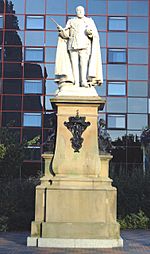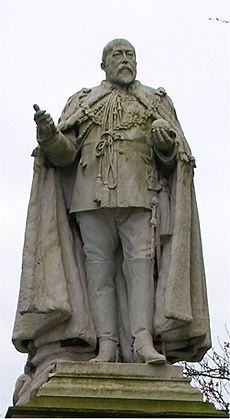King Edward VII Memorial facts for kids
Quick facts for kids King Edward VII Memorial |
|
|---|---|

The statue in 2013, after restoration
|
|
| Artist | Albert Toft |
| Year | 1913 |
| Medium | Carrara marble |
| Location | Centenary Square, Birmingham, England |
| 52°28′47″N 1°54′25″W / 52.479762°N 1.906906°W | |
| Owner | Birmingham City Council |
The King Edward VII Memorial is a special statue in Centenary Square, Birmingham, England. It was made to remember King Edward VII, who was the King of the United Kingdom from 1901 to 1910. This beautiful sculpture has a long history, including being moved around and needing repairs.
Contents
Remembering King Edward VII
How the Statue Was Planned
In 1910, a newspaper called the Birmingham Mail asked people for money. They wanted to build a statue to honor King Edward VII. People quickly donated over £5,000, which was a lot of money back then!
The plan was to place the statue near the Birmingham Children's Hospital. This hospital was then located on Ladywood Road, close to Five Ways.
Making the Statue
A talented artist named Albert Toft was chosen to create the statue. However, the project faced a challenge right away. The statue needed to be very tall, more than six feet high.
It was hard to find a single, big enough piece of Carrara marble for the statue. Carrara marble is a famous white stone from Italy. Luckily, they found a suitable piece, and the work continued through 1912.
Where the Statue Stood
The statue was officially shown to the public on Saint George's Day, April 23, 1913. This happened in Victoria Square. Princess Louise, Duchess of Argyll, who was King Edward VII's daughter, unveiled it.
The statue stood next to another statue of Queen Victoria. However, some people thought the two statues didn't look good together. In 1951, Victoria Square was redesigned. The King Edward VII statue was then moved to Highgate Park.
Missing Parts and Restoration
Over the years, some parts of the statue went missing. First, the lance (a type of spear) from the Saint George figure was gone. Later, in 1985 and 1986, three bronze groups were also removed. These parts were never found.
The Victorian Society, a group that helps protect old buildings and art, wanted the statue to be fixed. They asked the Birmingham City Council to restore it and bring it back to the city center.
In 2007, the Victorian Society started a fundraising campaign. They raised almost £12,000 to help pay for the repairs. This was more than 10% of the total cost!
Work on the statue began in 2009 by experts at Cliveden Conservation in Bath. They made new parts, including a sceptre (a royal staff) and an orb (a ball with a cross on top). They also recreated the three bronze groups.
These bronze groups represent important ideas:
- One shows Peace.
- Another shows Education and Progress.
- The third shows St George fighting a dragon under a crown.
The restored statue was put back together on its original base. You can now see it outside Baskerville House in Centenary Square.


